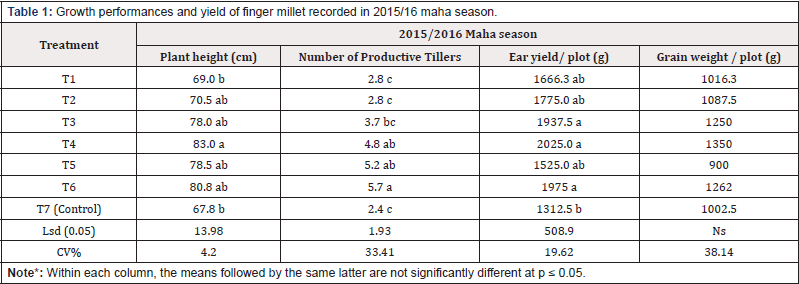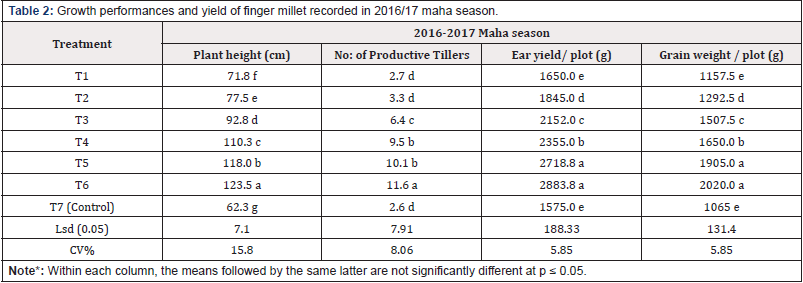Research Article 
 Creative Commons, CC-BY
Creative Commons, CC-BY
Effects Of Different Compost Levels on Growth and Yield Performance of Finger Millet (Eleusine Coracana L.) Under Low Input Conditions in Southern Dry Zone of Sri Lanka
*Corresponding author: D P P Liyanage, Grain Legume and Oil Crops Research and Development Center, Department of Agriculture, Angunakolapelassa, Sri Lanka.
Received: January 19, 2022; Published: January 27, 2022
DOI: 10.34297/AJBSR.2022.15.002109
Introduction
Finger millet (Eleusine coracana (L.) Gaertn) is a native plant to Africa and is a popular crop in tropics because it’s high nutritional value. It is a major food crop of the semi-arid tropics of Asia and Africa and has been an indispensable component of dry land farming systems [1]. Finger millet is also a hardy crop, less susceptible to pests and diseases than any other crop. It is a crop insurance against other crop losses repeatedly due to protracted droughts. Finger millet is a continuously grown crop in low country dry zone in Sri Lanka, generally without using organic or inorganic fertilizers [2]. As a crop belongs to family Poaceae, it is not able to fix atmospheric N. The regular depletion of nutrition status of land and the degradation of soil properties due to continuous cultivation in same lands without using fertilizers have resulted decreasing the productivity of crop cultivation [3]. Tough there is a recommendation for fertilizer application for finger millet cultivation recommended by DOA, farmers are not using inorganic fertilizers for the crop. The people in Sri Lanka, is considered the finger millet as a healthy food for several human health problems such as diabetes, cholesterol, etc. Though the demand for finger millet has increased recently but the annual finger millet production is decreasing. So, in this study, the compost used as main treatment with half of basal application of recommended amounts of inorganic fertilizers by DOA to find out the effect of compost application on enhancing the yield of low input finger millet cultivation under rain fed farming systems in Hambantota where is locating in dry zone of Sri Lanka.
Materials and Methods
This study was carried out to determine the effects of compost on finger millet yield under the rain-fed condition during the 2015/16 and 2016/17 Maha seasons at the Grain Legume and Oil crops Research and development Center of the Department of Agriculture. The experimental site belongs to DL1b Agro-ecological region in the dry zone. The rainfall pattern of the area shows bimodal distribution. Randomized Complete Block Design with 4 replicates and the plot size was 9m2. Seven levels of compost were used (0MT/ha, 1MT/ha, 2MT/ha, 3MT/ha, 4MT/ha, 5MT/ ha and 6MT/ha) as treatments in this experiment while the treatment without compost is considered as the control. The required amount of compost for each plot as each treatment was calculated according to the area of the plot. Measured amount of compost incorporated with the soil before seed sowing. Amounts of compost applied to the soil as treatments before seed sowing in both seasons. The levels of N, P and K of the compost which used in the experiment were 0.93, 0.34 and 0.6 respectively. Along with compost used calculate amounts as half of the DOA recommended basal application of inorganic fertilizers (25kg/ha of each of urea, triple super phosphate and muriate of Potash) for finger millet. All other practices were done as recommended by DOA. Finger millet variety Rawana was used in this experiment. Seeds were sowed in 30cm apart rows on prepared plots as recommended by the DOA in Sri Lanka [4]. Trials were established in early December 2015 in the 2015/2016 Maha season (Northeast monsoon). In the 2nd season (2016/2017 maha season) finger millet seed sowing was carried out in late November 2016. Finger millet plant data such as plant height and number of effective tillers were collected as growth parameters at flowering stage. Ear weight and grain yield were collected as yield parameters. Plant height and number of tillers were recorded as average value from ten plants of each plot. Ear weight and grain weight were recorded as a weight (kg) per net plot area. Net plot size was 5.76m2. All the collected data of growth parameters (Plant height, Number of productive tillers, weight of obtained ear yield and grain weight were statistically analyzed by Analysis of Variance (ANOVA) using SAS 9.1.3 portable package for parametric analysis and means were compared using Least Significant Differences (LSD) at 0.05 probability level (P<=0.05).
Results and Discussion
(Table 1) According to the data in 2015/16 maha season there wasn’t clear trend in plant height with the applied different amounts of compost, but in 2016/17 maha season results showed clear enhancement in plant height with the applied amount of compost. Highest value of plant height was shown by T6 which was applied 6Mt/ha of compost, while the lowest value of plant height was shown by the control treatment (T7) which was maintained without compost application (Table 1&2).
When the data on number of productive tillers is considered, similar trend could be seen with the applied amount of compost, lowest value obtained in application of 0Mt/ha and highest value obtained from the treatment which was applied 6 Mt/ha of compost. However, values reported in 2016/2017 maha season were larger than the values reported in 2015/2016 maha season.
Data on ear yield/plot were statistically significant but couldn’t see clear trend among treatments in 2015/2016 maha season. In the 2016/2017 maha season, there were clear trend and enhancement could be seen in ear yield/plot to the applied amount of compost.
The grain yield data did not show statistically significant differences among treatments in 2015/2016 maha season. However, the results obtained in the 2016/2017 maha season grain yields were statistically different in treatments and showed gradual increase with the applied amount of compost.
Overall obtained results indicate only slight effect of application of compost on growth and yield parameters in the 1st season (2015/2016 maha) of the experiment (Table 1). However, the results obtained in 2nd season (2016/2017 maha) showed considerable differences among treatments and gradual increase of yields with the increasing amounts of compost (Table 2). One of the possible reasons to get such results for growth and yield parameters is nutrients present in the compost are not fully available to crops within short term and it will take sometimes to release its own nutrients to soil. Therefore, the effects of compost to the crop’s growth and yield within 1st season were less pronounced. It can be assumed that regular use of compost may help to increase the yield. The obtained yields from T5 (applied 5Mt/ha of compost) and T6 (applied 6Mt/ha of compost) were in the same highest group in statistical analysis. Further experiments need to be conducted to find out the most suitable amount of compost for finger millet.
Conclusion
Effect of application of compost cannot be seen in one season, regular application of compost on soil leads to enhance the plant height, number of tillers and yield of finger millet.
References
- Kerr RB (2014) Lost and found crops: Agrobiodiversity, indigenous knowledge, and a feminist political ecology of sorghum and finger millet in Northern Malawi. Ann Assoc Am Geogr 104: 577-593.
- Liyanage D P P, Millawithanachchi M C, Samaranayake BN, Malanie LG, Abeywikrama LM (2015) Constraints of rainfed finger millet cultivation in Monaragala district in Sri Lanka Annals of the Sri Lanka Department of Agriculture 17th annual session pp. 375.
- (1982) Annual report for 1981. IITA- International Institute of Tropical Agriculture, Nigeria.
- (1999) Crop Recommendation techno Guide, Ministry of Agriculture development and Research, Department of Agriculture, Sri lanka.





 We use cookies to ensure you get the best experience on our website.
We use cookies to ensure you get the best experience on our website.